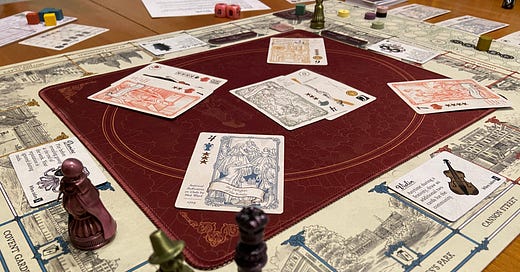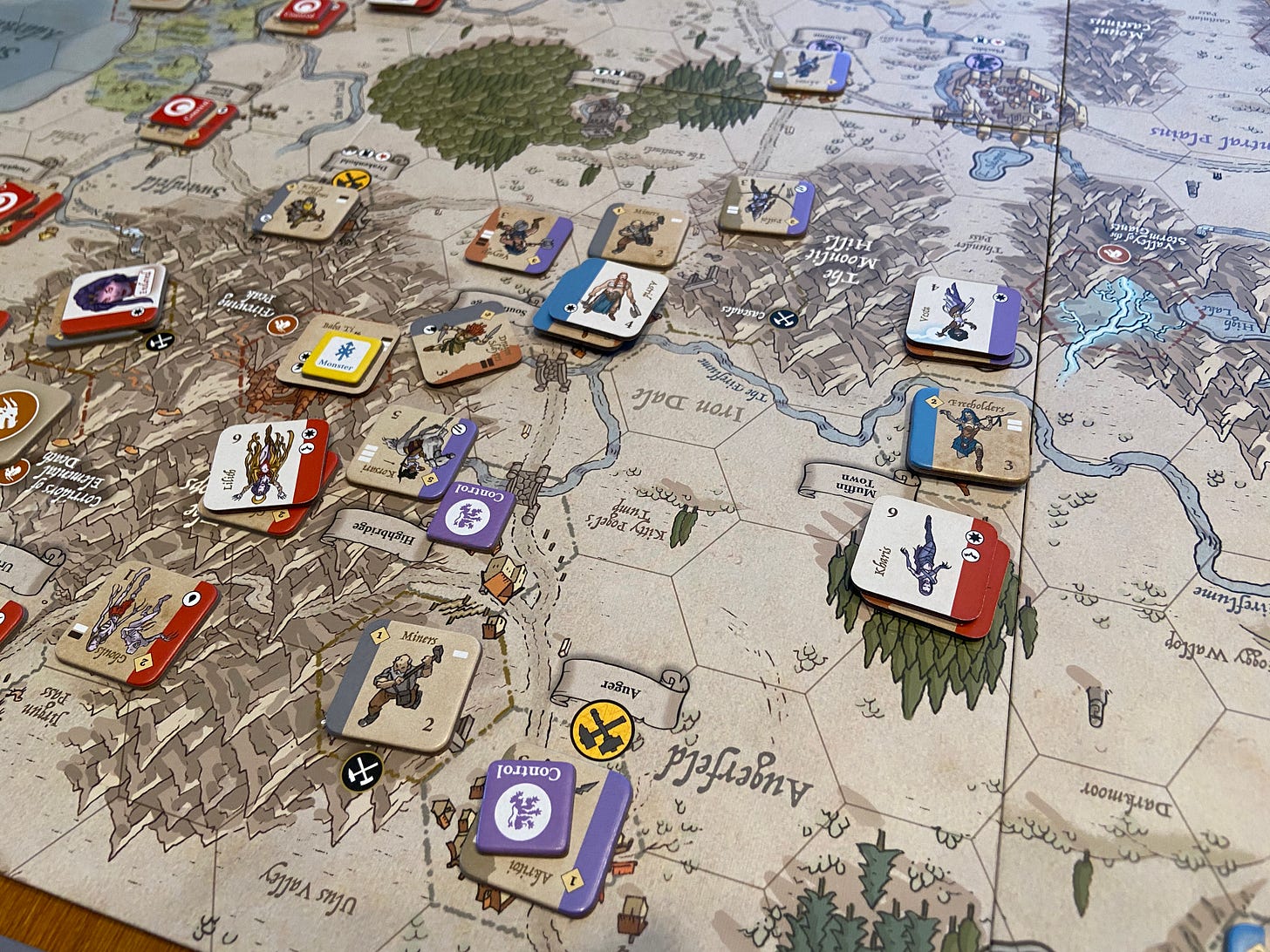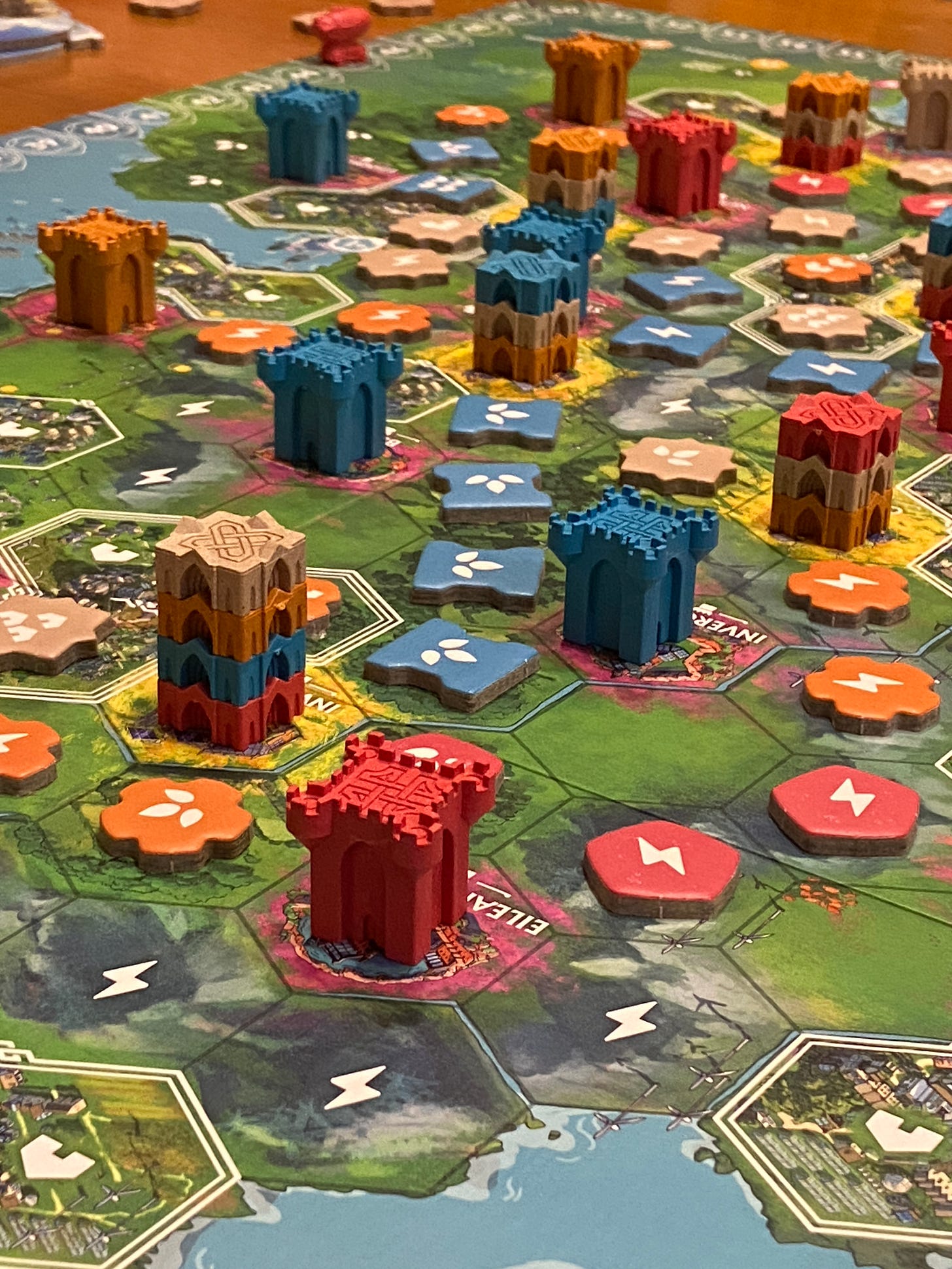Welcome to the new subscribers from Caroline’s Substack! Right now I’m relying on word-of-mouth to grow since I have virtually no social media presence anymore, so I really appreciate everyone who spreads the word.
I finally got chance to play some Molly House again, which I totally enjoyed.
Last time I talked about the game, I downplayed its “cooperative” vibe, which I feel like I should elaborate on now that I have a bit more experience. Interestingly, the game it reminded me of the most this time was Reiner Knizia’s Lord of the Rings. Even though there is virtually no overlap in terms of theme or mechanisms, the two games both try to give you a sense of community. Lord of the Rings tries to mould you into a fellowship by putting you through trials, while Molly House tries to give you a sense of being over-policed. I find that both are quite successful in this respect.
The difference is, Lord of the Rings is epic fantasy fiction and Molly House is the real world. The real world is messy and lacks satisfying character arcs or narrative throughlines. People are all different and they deal with things differently when under pressure. I think the cooperative element of Molly House is maybe a bit stronger than I gave it credit for last time, although it feels like that flavor is a relatively minor part of the experience by default. Lord of the Rings succeeds by putting you under a lot of pressure to cooperate. In Molly House the primary pressure is self-interest. But there is some sense of cooperative pressure as well. The interesting thing is that I think it pulls off that balance very well, to the point I didn’t even really think about it — which is pretty rare — and it certainly doesn’t play like a co-op.
A question I’ve seen making the rounds is asking where Molly House lies on the “narrative/experience game” to “competitive game” continuum — how much of the value of the game is in the sense of setting or narrative, vs friendly competitors with your fellow-players. In general I reject the premise here, and find it to be a false dichotomy. There are certainly games like Tales of the Arabian Nights on one end or maybe Civolution on the other where you can only really engage with the game in the one way and trying to play competitively or find narrative satisfaction will be futile. But almost all hobbyist games are themed for a reason, and there is no reason they can’t fully engage you in both ways. Lord of the Rings is highly narrative, but also a serious game you have to play to win. These characteristics are not opposed. It’s just a question of how much a game can deliver on each. Molly House is chaotic certainly, and there is more negotiation and engagement with the social elements of gaming here than there is in many euros — in small ways it reminds me a bit of Zoo Vadis from last week as you try to figure out your route to victory and how you’re going to play off the other players — but it is still essentially a core euro, far moreso than John Company or Pax Pamir 2nd. You need to manage two key things. Firstly, your reputation. Increasing it enables scoring joy, but comes with risk of exposure. Joy is how you win if the community survives, but if things go sideways and the community gets infiltrated then you need to hit a sweet spot where you have enough reputation that the police will find you useful as an informer, but not so much that you’ll get majorly indicted. So that’s tricky. And secondly, you have to balance your attention between the four houses (suits). If you focus on one suit it will be easier to score, but it will also cost you a lot of flexibility. If the green house is getting raided and you’re the only one with reputation there, you’ve got a major problem.
So! There is a lot of narrative and emotional engagement here, but there is also a lot of gamerly engagement. It’s a little chaotic and highly interactive so it has a very classic euro feel, although at a slightly higher (but still highly approachable) complexity level.
Speaking of which, I’ve also seen a lot of players struggling with the rules. For all of Wherlegig’s considerable skills as a game publisher, they do not create great rulebooks which is unfortunate. That having been said, I did not find the complexity at all problematic. Once you understand what the game is trying to do, how the game mechanics are trying to pressure you, it all clicks together nicely. To me it’s certainly less complex than modern doorstop euros. But there is absolutely a learning curve on it. Managing the Festivities and the Community Infiltration victory conditions (informants) are the two hardest things and they are definitely a bit finicky and you’ll need to step through them carefully at first. And even once they’re understood mechanically, how to manipulate them is not very clear initially. There is a lot of nuance to the game so there is a lot to explore. But just from a standpoint of learning to play, it should not be particularly daunting.
I’ve played Bitewing’s Cat Blues (their remake of Katzenjammer Blues) a few times recently and I’ve found it to be a fun game. But it’s also a very unique game, not much like anything else you’ve played, and in that way it’s interesting to think of in contrast with Molly House. Cat Blues has the things that those of us who are Knizia fans crave from him: tightness, nuance, subtlety, a quick pace of play, deceptive depth. It’s very easy to explain, plays at a good clip, and forces you to make tough decisions. The tension of the Jokers adds excitement.
It’s also opaque, in a way that I associate with some of Knizia’s less-elegant games from the late 90s. Since Molly House is set in the real world and trying to say something about it, you can work your way through it. One thing about the game that people find confusing is how cards move through the deck, safe, and gossip piles; but once you know what the game is doing, it’s not hard to see the structure. Cat Blues, while obviously much simpler, is totally abstract and doesn’t give you anything to hold on to. So it can be bewildering, and since it’s so unique you don’t have much of a starting point to know how to approach it.
I like Cat Blues; it’s clever and unique, which are things I probably over-value compared to most gamers. People I’ve played it with have not found it so engaging however. I feel like perhaps it’s because the game feels somewhat ostentatiously clever; clever but it’s not clear whether that cleverness is in pursuit of anything. Knizia is at his best when the games are elegant and seamless and you don’t have to think about how the mechanisms work, like Quest for El Dorado, Beowulf, HUÀNG, or Amun-Re. I’d still recommend you try Cat Blues, if these kinds of shorter, lighter card games are your thing. But it’s definitely a throwback to a quirkier period in the history of Knizia’s game designs.
I’m sure nobody wants this to turn into a Burning Banners blog, so I’ll keep that in mind. For now, I’m still discovering interesting things about it. This was Campaign 17, The Undead Empress. In the fiction, it takes place after the Witch Queen was defeated and her Spire of the Moon taken in the main arc the game covers. Unfortunately the living apparently forgot to kill (destroy?) her after all that, and she came back and subverted the Eastern Empire. So we have an excuse to setup a unique matchup: Eastern Empires (Byzantines-ish) and Army of the Night (undead) vs the Oathborn (dwarves) and Fjordlings (Vikings).
For me this was interesting because it was the first genuinely large-ish scenario I’ve played, with action taking place over two full map boards with each player controlling two factions. It was longer and more head-explode-y than I expected, given how totally manageable the smaller scenarios are. We played about 3 hours to an instant victory, but it would have probably taken 5 hours to get to end (and we are quick players). There is a lot going on here with three or four different major loci of action and things just generally all over the place. I enjoyed it, but don’t be fooled by the 2-faction scenarios. This definitely felt large.
My opponent, who has played this game quite a lot including being in the middle of his second full campaign, said that they now use a house rule: each empire can only loot one lair per turn. After this game, I think that’s a good rule which I’ll adopt. In the smaller scenarios the lairs can be a crap shoot, but on the scale of a scenario like this they become more predictable and it feels like perhaps the strength of looting lairs is underappreciated in the design. The Eastern Empires here are large and powerful and on the first turn of every year they just hit the many lairs they could reach, which is very likely to be both substantially net gold-positive and result in them having a fistful of treasures. They and the Army of the Night are unusual in their ability to loot lairs due to their Psiloi and Plague Rats respectively which are cheap and have ranged and ambush and can take out many land monsters pretty easily. I think a house rule to rein that in for the large scenarios seems wise, and limiting how many lairs a faction can loot in a turn seems a simple hack.
There seems to be a bit of dispute online as to whether looting lairs is worth it. Trust me, even in the small scenarios you should do it — at least on land. The sea monsters are definitely tougher and not so obvious. That said, the MVP of this game for me was Babi Ti. Her lair turned into the Eastern Empires’ Stalingrad, surrounded by the remnants of the shattered units they had sent to try to take to her down. Easily three times the GDP of Fjordland got sunk into that project. Don’t do that.
There have been a number of flashier games out recently, so Rebirth has been a bit edged out for table-time. I think I’ve mentioned that for long-time gamers Rebirth is in a little bit of a tough spot, because it clearly rhymes with a number of Knizia’s older games — Samurai, Through the Desert, Babylonia — and so in some ways it feels fairly familiar. But is it? I don’t know, I’m just asking. The thing about Knizia is that despite his massive ludography, he almost never repeats himself unless he’s specifically updating an old design. Yes, Rebirth has echoes of those older games, but it’s fully 2020s Knizia: no more opaque scoring methods, just a clean design with clear and easily understood mechanics and short rules but way more depth than you expect. It was great to play it again.
Coda
In honor of the new batch of subscribers from the UK!
That’s it! See you next week!








This content is the reason I've always enjoyed reading your thoughts on games. Cole Wehrle on one end, Reiner Knizia on the other.
I wouldn’t object if you turned this into a Burning Banners blog. I haven’t played that game yet but that’s only because I’ve only played 5 boardgames in the last 9 months.